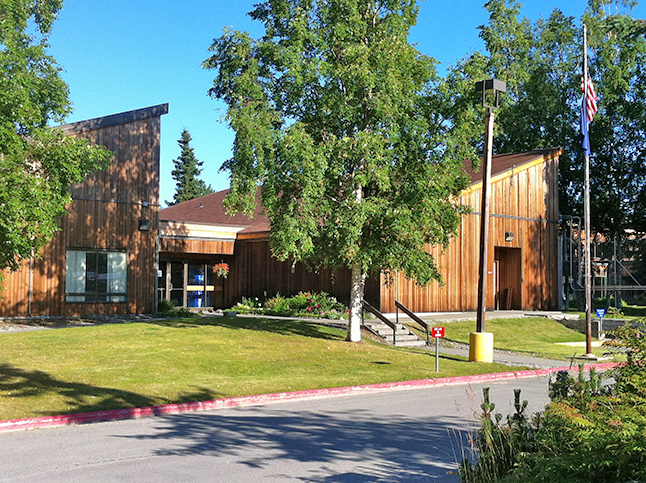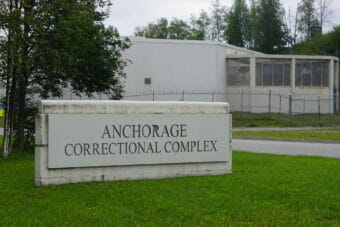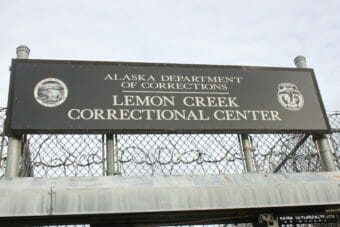
Early one morning this summer, Nora Brown got a knock on her door in White Mountain, a small community near Nome. It was a village public safety officer letting her know that her 20-year-old daughter, Kitty Douglas, had died in jail. She had only been there for six nights.
It was a shock – they had talked on the phone recently, and Brown thought her daughter was safe at Hiland Mountain Correctional Center after bouncing between an Anchorage youth shelter and homeless camps.
Douglas is the youngest of 15 people to die in Alaska jails and prisons so far this year. Nine out of 15 were under 40. The Alaska Department of Corrections hasn’t had this many deaths in one calendar year since 2015.
It’s unclear what’s behind this year’s high, and why seven people died within two weeks of going into custody. The department hasn’t published the causes of death, with the exception of 91-year-old James Patrick Wheeler. His death in July was related to COVID-19.

The Department of Corrections’ screening process, record-keeping policies and security practices mean there should be lots of documentation of what led up to the other 14 deaths. But the department says it can’t disclose much; they’re limited by confidentiality policies and health privacy laws.
Family members and activists are sounding the alarm that these deaths are a crisis that needs special attention.
Brown said the VPSO who delivered the news in White Mountain didn’t know specifically what happened to her daughter, Kitty Douglas, but she later found out through the State Medical Examiner that Douglas died by suicide. She’s learned little else from the authorities.
“This was avoidable. I know it,” Brown said.
According to Brown, her daughter thought she was in trouble for shoplifting when she called from jail. Online court records don’t list any charges against Kitty Douglas that would have led to her imprisonment at the time.
Brown said her daughter had some known mental health issues and should have been under close watch.
“‘I would rather die instead of be in jail.’ That was some of the things she expressed to some people here when they talked of jail,” Brown said. “That was her trigger thought. ‘I would rather die instead of be in jail.’”
Brown said she wants to file a wrongful death case against the state.
“I would like to see them do their job, follow their own guidelines, and do what they could do, best they can,” Brown said. “Especially with people that they know are suicidal. … People that they know that have mental illness and things.”
A Department of Corrections spokesperson said in an email that the department takes each death seriously and conducts its own internal investigations, which include looking for trends or underlying issues.
A federal report shows that historically, illnesses are the leading cause of death among Alaska’s inmates, followed by suicide and then drug or alcohol intoxication.
The corrections department says that it does not suspect foul play in Kitty Douglas’ death or any of the others this year.
That doesn’t absolve the department of responsibility, according to Megan Edge, director of the Alaska Prison Project for the American Civil Liberties Union of Alaska.
“‘No foul play’ does not mean that these people didn’t die at the hands of the system. That’s 15 people, some of (whom) were not convicted of crimes, who were not sentenced,” she said. “There are people who were convicted but not sentenced to death, dying at the hands of the system.”
Edge said her organization hasn’t taken any legal action against the state, but it is working with some families of inmates who have died this year and community groups. She said letters were sent to the administration last week asking the state to preserve evidence, such as prison video recordings, in anticipation of future litigation.
The organization is also calling on Gov. Mike Dunleavy’s administration to conduct a sweeping review of the deaths and other prisoner conditions.
“It’s really important that this investigation is done by an independent body, not the state investigating itself,” Edge said. “And that the findings of the review are made public. That’s how we ensure accountability and transparency.”
From there, she said community leaders and policymakers can work on solutions.
Some family members, like Nora Brown, have learned the immediate cause of their loved ones’ deaths by getting records from the State Medical Examiner’s office themselves. Next of kin are entitled to those reports, but they usually aren’t public.
The corrections department spokesperson said that many inmates come into the system with “preexisting, and in some cases, very complicated medical and mental health issues.”
Edge said that underscores why they should not be in a jail cell.
“That’s why they should be being treated by medical professionals,” she said. “That’s why they should be in hospital, that’s why they should be in treatment. You know, the reality is, the Department of Corrections is not staffed well enough or trained well enough to triage this crisis.”
Edge said that’s both an indictment of the prison system and a call for change beyond it to address contributing factors like substance abuse, a lack of mental health care and the criminalization of poverty.
Several inmates who died were only facing misdemeanor charges. Court records show that a law firm that serves as the public defender for municipal crimes in Anchorage was representing several of them.

Kitty Douglas is back home in White Mountain now, where she was buried in July.
Normally at this time of year, Nora Brown said her daughter would have finished picking berries for the season and had her silver salmon smoked and put away. She’d be climbing trees to find rabbits and ptarmigan to hunt, bear and moose to avoid.
“She would just climb a tree … any tree she looked at. She would probably climb it right in front of you just to show you she could,” Brown said. “She was just really, a really bad tomboy.”
Brown doesn’t have closure. As the inmate death toll has risen this year, she wonders, why so many?
Correction: An earlier version of this story included a photo caption with an incorrect date. The photo of Kitty Douglas cleaning fish is from August of 2018, not September of 2019.



